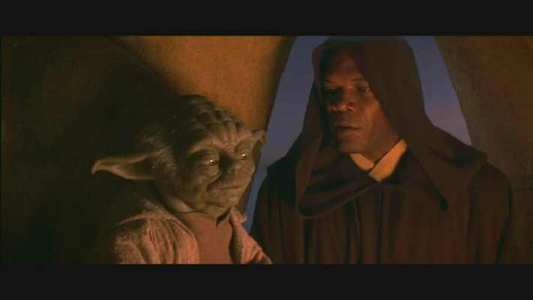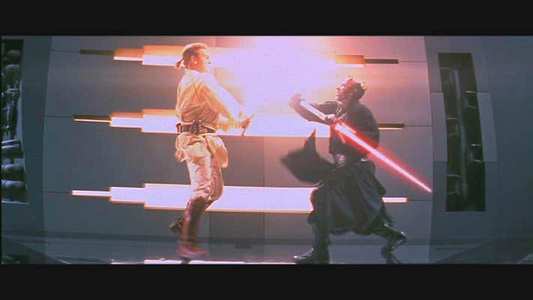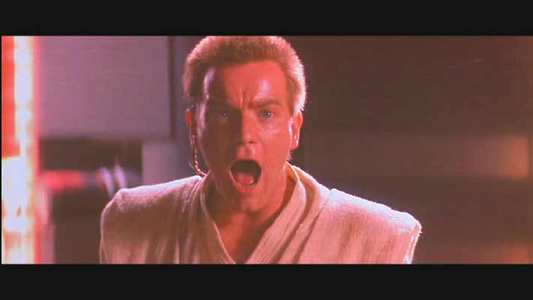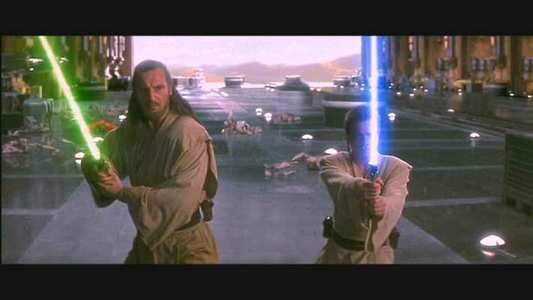Review of Star Wars: Episode I The Phantom Menace (2 Discs)
Introduction
When I first started writing about films, I submitted a Visitor`s review for The Phantom Menace to this site. Looking at it again, it seems somehow inadequate and not detailed enough. I also wrote it with a sense of anticipation for Episode II, which has led to it being dated somewhat. So, I have decided to take another look at the first Star Wars film, and revisit my original thoughts and craft another review, a better review with more CGI. If it`s good enough for a certain director then it`s certainly good enough for me…
Like many Star Wars fans, I first saw Episode IV when I was a child and I was instantly hooked. Consequently I have grown up with the original trilogy and to some extent Star Wars grew up with me. Up until the late eighties, the three films were all there were for many people. But then new, officially sanctioned stories started to appear, both as novels and comics. These stories were what we all wanted, Star Wars had grown up, and the stories reflected this, darker themes were examined, the universe was fleshed out in tales spanning thousands of years. For example the current series of novels, The New Jedi Order, share more in common with the Aliens movies than the original Star Wars trilogy. I was very much aware that all this would colour my expectations when the Phantom Menace was finally released.
Most Star Wars fans were under 10 years old when they saw the first movies. Obviously they were the target audience. It`s no surprise that the new films would be targeted at that age range also. Star Wars movies are for kids, that we as adults enjoy them too is a bonus. So when I first saw The Phantom Menace, I tried to approach it with an open mind. I`ve seen it several times since, most recently on DVD and guess what, it`s a good movie.
A trade dispute threatens the sovereign world of Naboo. The taxation of trade routes by the Republic has led to the Neimoidian dominated Trade Federation to blockade the peaceful world until their demands are met. Two Jedi, Qui-Gon Jinn and his young Padawan, Obi-Wan Kenobi have been sent to mediate a peaceful settlement between the two parties. However, they arrive to find that there are darker motives to the events, especially when the Neimoidians send droid soldiers to kill them. The Jedi escape this trap and make their way to the planet`s surface, barely ahead of a full-fledged invasion. The Trade Federation themselves are only pawns of a mysterious dark figure Darth Sidious, a Sith Lord who is manipulating Galactic events to his own purposes.
With the aid of a Gungan inhabitant, Jar Jar Binks, the Jedi make their way to the Naboo capital, where they succeed in liberating the Naboo leader Queen Amidala, and persuade her to accompany them to Coruscant, the centre of the Republic. There she will be able to present her world`s case to the Republic Senate. But escaping from the Federation blockade proves problematic, and their damaged spaceship can only limp as far as Tatooine, a world outside the Republic`s sphere of influence. Attempting to secure replacement parts, Qui-Gon encounters a precocious young slave, unusually strong in the Force. When it becomes apparent that the only way to buy the replacement parts is to wager on a Pod Race, Anakin Skywalker proves adept at piloting a machine that no human can handle. But the Sith are determined to prevent Amidala testifying to the senate, and Sidious` apprentice Darth Maul is soon hunting the Jedi down.
Having freed Anakin from slavery, and convinced that he is the fulfilment of prophecy, Qui-Gon and the others arrive at Coruscant, where he attempts to convince the Jedi Council that the boy should be trained as a Jedi, despite his age. Meanwhile Amidala finds the Senate is a bureaucratic web that is drowning in procedure and corruption. When Chancellor Valorum is forced to stall on the Naboo issue, she has no choice but to call for a vote of no confidence, an act that leaves the path to the leadership open for a certain Senator Palpatine…

Video
Two years ago, when I first wrote about The Phantom Menace, I felt justified in my raving about it`s image quality. It is good, but since then a little thing called Attack Of The Clones has happened, and totally blown the opposition out of the water when it comes to image quality, and that includes its forebear. A 2.35:1 anamorphic transfer that is well defined, colourful and vibrant showcases The Phantom Menace. Only nitpicking reviewers can really notice the barest hint of grain, or the rare speck of dirt.
Star Wars has always had a singular visual style, and that is no less true for The Phantom Menace. However the 16 or so years separating the two trilogies has seen a revolution in effects technology, and The Phantom Menace goes one step further in advancing the trends. In many ways it`s a curious blend of old and new, with CGI competing with traditional effects. CGI is used to paint the new Star Wars worlds, allowing for fantastic sets and amazing vistas. However when it comes to the alien characters there is a battle for supremacy, with digital characters like Jar Jar and Sebulba looking very impressive, while traditional puppetry and animatronics used for characters like Yoda. Yoda actually looks less realistic than in the earlier films, feeling out of place in the pristine Jedi Temple as opposed to the organic jungle of Dagobah.

Audio
Another teeth loosening THX trailer heralds the start of the movie, and Lucasfilm lives up to its reputation of cutting edge sound quality. A DD 5.1 EX English soundtrack is supplemented by a DD 2.0 Surround track. The Phantom Menace boasts stunning sound, with astounding recreation of the effects and music. Two words for you… Pod Race. `Nuff said.
Star Wars is 50% George Lucas and 50% John Williams and his music provides that unmistakeable Star Wars feel, especially when that yellow text starts scrolling into the distance. With Duel Of The Fates, he has created some of the most poignant and resonant themes yet in Star Wars, and it certainly complements the climactic battle perfectly.

Features
Disc 1
The first disc presents the film with a choice of three animated menus based on three of the planets shown in the film. You will also find a THX optimiser as well as an Easter egg that has some of the outtakes of the movie playing with the DVD credits.
Finally there is the audio commentary provided in DD 2.0 Surround by George Lucas, Rick McCallum, Ben Burtt, Rob Coleman, John Knoll, Dennis Muren and Scott Squires. Each voice is announced by a caption on screen and each contributor will discuss his own particular area of interest. The comments are usually unrelated to each other but are always relevant to the scene. As a commentary it`s very good and certainly interesting if disjointed.
Disc 2
The second disc is practically brimming with extras, and I`ll just summarise them here.
Trailers & TV Spots.
This section contains the Teaser and Theatrical Trailers presented in 2.35:1 anamorphic, as well as the Duel Of The Fates music video in 1.85:1 letterbox. A subsection contains the TV spots. This comprises 5 tone poems, and two trailers, all presented again in 1.85:1 letterbox.
Deleted Scenes & Documentaries
The deleted scenes (2.35:1 anamorphic) can either be seen alone or in conjunction with a documentary. There are 7 scenes, lasting 17 minutes in total, having been especially completed for the DVD. 1 scene has been restored in its entirety to the film, and the Pod Race Sequence in the film is also extended over the theatrical release. There are also a couple of Easter Eggs here that will play featurettes for the deleted Pod Race scenes. The documentary that encompasses these scenes, of you choose to watch it adds another 21 minutes of material, comprising interviews explaining why the scenes were deleted, the philosophy of editing with reference to other films, and concludes with some entertaining end credits.
The Beginning: Making Episode 1 is the icing on this particular DVD cake. Presented in 1.85:1 anamorphic and lasting over an hour, this goes from storyboards to the release of the film, and encompasses everything from pre-production, casting, special effects, location shooting, music and editing. It`s in the form of a fly on the wall documentary with no voice over and is as interesting as the film itself. It certainly sets the standard for DVD extras.
Featurettes & Web Documentaries
There are 5 featurettes, looking at the visual effects, costumes, design, fight choreography and the story. Presented in 1.85:1 anamorphic these run for a total time of 40 minutes.
The 12 Web documentaries also presented in 1.85:1 anamorphic look at various aspects of the film, like the writing, sets, props, aliens, R2-D2, John Williams, location shooting, the work of Assistant Directors and much more. All together these last for an hour, and provide more specific insights into the making of the film.
Animatics & Stills Galleries
The stills galleries are filled with images. There are loads of Production Photos, which you can examine with or without informative captions. The International Poster campaign is a little disappointing, as it seems to amount to the same picture but different language-writing underneath.
The Animatics look at the visualisation process of certain scenes, and looks at the stage in-between the storyboards and the final film. There is a 2-minute introduction followed by a look at the Pod Race and Submarine sequences, with the option of looking at 4 angles.
Finally there is the 4-minute look at the making of the Starfighter Game, the one moment of tackiness in an otherwise outstanding presentation.
English subtitles for everything by the way.

Conclusion
Watching The Phantom Menace now, with reference to Attack of the Clones, gives a different perspective to the film. Characters introduced here grow and mature, and events that occur in the first movie are lent weight by the subsequent film. While the first trilogy certainly concentrated on events of a galactic importance, the stories were told from a very personal viewpoint, allowing audiences to relate with the characters far more easily. Episodes 1 and 2, though 1 especially try to paint a far broader canvas. This is a story about trade blockades, political infighting and Machiavellian manoeuvring. It`s a story told on a grand scale and audiences are given less opportunity to relate to the characters. Episodes 1, 2 and the inevitable 3 are far more cohesive as a whole, it truly is one film split into three, rather than three separate stories, and when you watch Episode 1 in context with the subsequent films, you get a better appreciation of what George Lucas is attempting to accomplish. It`s a more thoughtful, measured way of storytelling that has certainly increased my enjoyment of the first film. While the onus is on Anakin Skywalker`s fall to the dark side, it`s actually the hints and implications regarding the Emperor`s rise to power and the fall of the Jedi that are more interesting. The Phantom Menace is getting better with time.
Yes of course there are criticisms, the contrived appearance of C3P0 for one, some unfunny alien accents for another. Most people would cite Jar Jar Binks as a prime example of a needless distraction. My reply is that I take your Jar Jar and raise you a forest full of Ewoks. You can`t deny that children like Jar Jar and I have to say that after repeated viewing the character has grown on me. Jar Jar is an easy target and does tend to overshadow many of the films other more serious shortcomings. George Lucas` biggest problem is that the world has collectively looked at the last page of the book. Everyone knows how the saga ends, so anything made prior to the original trilogy will be by nature anticlimactic. You have four characters that must survive, Yoda, Darth Vader, the Emperor and Obi Wan Kenobi. Anyone else is `bantha fodder`, to coin a phrase. The original trilogy also dealt heavily with archetypes, the supreme evil in the emperor, the fallen angel in Darth Vader, the redeemer in the son, Luke Skywalker. It examined themes of redemption, betrayal and loss, hope and sacrifice that have remained common in tales told through the ages. Such pure and simple themes could never be matched by the prequels, as they must by their very nature build up to the final films.
It is also a cliché that lightning never strikes twice. In the original trilogy, George Lucas had an amazing cast in Mark Hamill, Carrie Fisher and Harrison Ford. The chemistry that the principals had was what drove the trilogy. It was the interactions between these characters that gave the trilogy its magic and unfortunately that hasn`t happened in The Phantom Menace. It is easy to blame this on the preponderance of high tech effects, but you must remember that the original films were also effects heavy films, but didn`t suffer. The cast in the first film is often less impressive, though that is most likely down to George Lucas` philosophy of filmmaking. The preponderance of bluescreen aside, he demonstrates quite clearly in the extras that if he isn`t happy with a performance, he`s far more likely to correct it in the editing suite rather than with the actors on set. Of the cast, Liam Neeson impresses as Qui-Gon Jinn, with Ewan McGregor visibly finding his feet as Obi-Wan Kenobi, oft-times seeming too much of an Alec Guinness impersonation rather than making the character his own. It`s a small flaw that certainly doesn`t affect the second film, where he is more assured. Ian McDiarmid is impressive as Senator Palpatine, creating a multi-layered character that is probably the best performance in the film. I must say though that with every viewing of the film, I find Jake Lloyd`s performance as Anakin Skywalker just a little more annoying. Blue eyes, blonde hair and unprecedented wholesomeness that epitomises the Hollywood ideal of a young boy just doesn`t fit in with the character that Lucas is trying to create. While George Lucas` dialogue is unwieldy for the best of actors, it just doesn`t work at all with young Anakin. Natalie Portman is entertaining enough as Queen Amidala and is certainly less wooden than in Episode 2, but the film belongs to an amazing performance from Ray Park as Darth Maul. His brief appearance is enough to electrify the film, and it`s the ultimate battle between Jedi and Sith that will stay with you after the end credits have rolled. Although following a Sith tradition, Darth Maul has his voice dubbed, as Vader did in the first films.
Despite my open mind, I still have a couple of gripes like other Star Wars fans. First the biblical allusion is tacky and out of place. Anakin Skywalker a result of Immaculate Conception? There is just no need for it. And what`s with the midi-chlorians? What`s the deal? Originally the force was mystical energy field created by all life in the galaxy, really cool and quasi-religious. Now it`s a disease, it`s a bad case of the flu. Oh man!
It`s by no means perfect, but it is Star Wars and it does entertain. It`s got the elements we want, Jedi and Sith, lightsabers and space battles, brilliant action sequences and mind blowing special effects. The story is competently told and the performances are for the most part, excellent. Anyone under the age of 10 will love this film, and though us 20-something and 30-something fans will moan at the fact it`s not what we wanted and it doesn`t match the original trilogy, we will still shell out for it in our millions and watch it just as avidly. The DVD has the extended pod-race, so one of our favourite bits gets three minutes longer. The climactic lightsaber battle is still the best lightsaber fight, ever! That indescribable thrill that occurs when John Williams` breathtaking theme explodes as the yellow text scrolls away to infinity is still there. Despite the shortcomings, I`d defy you to watch at least some of this film without a silly grin on your face. I love it!
Your Opinions and Comments
Be the first to post a comment!